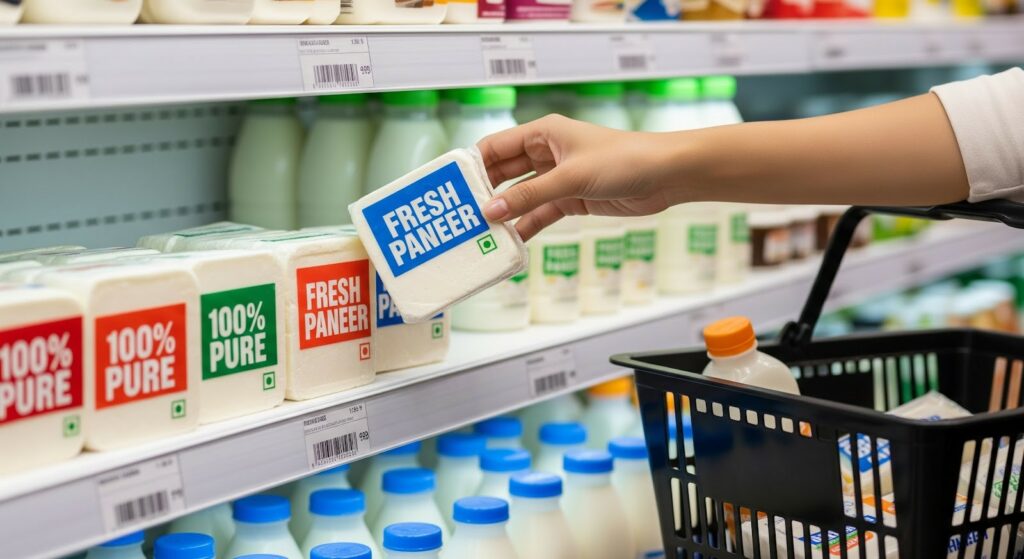Paneer is a cornerstone of vegetarian cuisine in India, loved for its versatile flavour and high protein content. From palak paneer to paneer masala tikka, this fresh cheese powers countless meals and fuels muscle repair for those who forgo meat. Recently, however, food‐safety authorities have uncovered worrying cases of starch, detergent and even urea being . These malpractice cases underline the need for every consumer to learn how to identify pure paneer and keep adulterated products off the plate.
What Does Paneer Adulteration Mean?
Adulteration has become a dire challenge that impacts several food items, particularly paneer, which is widely used in Indian kitchens. The act of tweezing is done by combining precious or even dangerous items with foods such as paneer, which would increase its weight or shelf life. The effects of consuming adulterated products such as paneer can be catastrophic, especially for the lacto vegetarians who depend on dairy for fundamental building blocks of the body and other vital nutrients.
Typical culprits include:
- Cornflour or tapioca starch – to bulk up mass.
- Detergent or synthetic whiteners – to enhance colour and texture.
- Urea or neutralisers – to give a fresher smell despite spoilage.
For vegetarians who rely on dairy for essential amino acids, calcium and B-vitamins, ingesting these additives poses real danger. Understanding pure vs adulterated paneer is therefore critical to long-term health.
Health Risks Linked to Adulterated Paneer

The health risks associated with the consumption of paneer with even trace amounts of chemical are profound. Such chemical adulterants might lead to severe side effects, including bloating, diarrhoea, skin rashes, severe allergies, and inflammation of the respiratory system.
In addition, the chemical residues in question can permanently damage the liver and kidneys, indicating grave health risks. For vegetarians, a reliable guide for the detection of paneer adulteration is imperative because such information protects vital organs that silently perform complex metabolic functions in the body while simultaneously ensuring the product’s taste and quality.
Simple Home Tests for Adulterated Paneer Detection

Detecting adulterated paneer is easier than you think, and you don’t need any special equipment. Here are five simple tests you can perform at home to check the quality of your paneer.
1. The Look, Smell & Feel Test: A Quick Check
Start by observing the appearance, smell, and texture of the paneer. Pure paneer is typically off-white in colour, not stark white. It should have a mild, milky aroma without any sour or soapy smells. When you press it gently, it should spring back; if it’s too soft or rubbery, it might be adulterated.
2. The Warm-Water Crumble Test: Easy and Effective
To perform this test, drop a small cube of paneer (about 1 cm) into a glass of warm water. If it’s pure, it will retain its shape with a slight crumble at the edges. However, if it disintegrates quickly and clouds the water, it may contain excess starch.
3. The Iodine-Starch Test: A Simple Chemical Check
Mix ½ teaspoon of paneer with 2 tablespoons of warm water, then add two drops of iodine solution (available at pharmacies). If the mixture turns blue or black, it indicates the presence of starch. Pure paneer won’t react this way; the solution should remain brownish.
4. The Detergent-Foam Test: Check for Soap or Detergent
Grate 5 grams of paneer and shake it in a jar with 30 ml of warm water. If the mixture produces persistent foam, it may be contaminated with detergent or soap. If the foam disappears quickly, it’s likely safe.
5. The Acidic Coagulation Test: Check for Authenticity
Authentic paneer is coagulated with food-grade acid, such as lemon juice. To verify, place a small cube of paneer on your tongue. If you detect a hint of citrus, it’s likely genuine. However, if it feels chalky, it may have been coagulated with chemicals.
Buying Smart: How to Source Pure Paneer

Straight away picking high-quality paneer starts with the point of purchase. With knowing a few of the particulars to watch out to avoid buying sub sorts of paneer, gives you peace of mind that you are choosing the right one.
Here is an important checklist for buyers:
When purchasing paneer, it is prudent to begin with trusted and reputable outlets. Select FSSAI-approved works and cooperative milk societies. They will most probably follow established quality regulations So “no” to these labels which indicate the strange content of “starch” or “milk solids plus additives” into other substances and other preservatives.
These two also must not be left out particularly for buyers who value freshness. Fresh paneer usually has 3-7 day refrigeration life. Freshness is in danger if the item is not checked for date so endanger health. Another important choice is purchasing vacuum sealed oscillating packs. Loose paneer allows the product to be exposed to airborne vesicles which are capable of contaminating the paneer.
The best approach is to make it at home. Use full cream milk from a trusted dairy or buy packed full cream milk. Here is a YouTube Short that shows how to make Paneer at home.
If you cherish honesty and eco-friendliness, backing regional organic farms that are open for visits can be a great approach to knowing where your paneer firangi is coming from. Observing the measures and cleanliness maintained can assure you of the product’s value. Following these procedures will ensure that the paneer you consume is wholesome, tasty, and authentic.
Storage & Freshness Hacks
Paneer is a delicate dairy product that can spoil quickly, especially during the hot Indian summers. To maintain its freshness and quality, proper storage and handling are essential. Here are some simple yet effective tips to help you keep your paneer wholesome and delicious.
To start, it’s crucial to store paneer in the refrigerator at a temperature below 5 °C. For optimal freshness, it’s best to consume it within 48 hours. If you need to store it for a longer period, you can keep it fresh by immersing the block in a container of fresh, lightly salted water. This will help maintain its soft texture.
If freezing is necessary, be aware that it can affect the texture of the paneer. To minimize this, thaw it slowly in the refrigerator rather than at room temperature. By following these simple storage and handling tips, you can enjoy your paneer at its best, ensuring that every last morsel remains wholesome and delicious.
Frequently Asked Questions
Does a softer texture always mean it’s adulterated?
Not always; buffalo-milk paneer is naturally softer. Combine texture clues with chemical tests for accuracy.
Are branded products always safer than local?
Branded items offer traceability, but small farmer co-operatives that follow hygienic practices can be equally reliable.
Can lactose‐free paneer be adulterated?
Yes. Speciality labels do not guarantee purity; perform the same tips to check paneer quality.
Conclusion
Maintaining a healthy vegetarian diet hinges on trustworthy dairy. Investing two minutes in basic checks can spare you prolonged health troubles. Whenever possible, choose organic or co-operative dairies where transparency is built into their business model. By mastering adulterated paneer detection and practising mindful purchasing, you ensure that every bite of sabzi or paratha stuffing provides clean, unadulterated nutrition, nothing more, nothing less.
Stay alert, share these guidelines with family, and turn every meal into a celebration of purity and wellness.
Disclaimer:
The information provided in this blog is for informational purposes only and is curated from reputable sources across the web and based on my subject knowledge. I am not a certified nutritionist, dietitian, or medical professional. So, I would suggest, always consult with a qualified health expert before making any significant changes to your diet or lifestyle.

